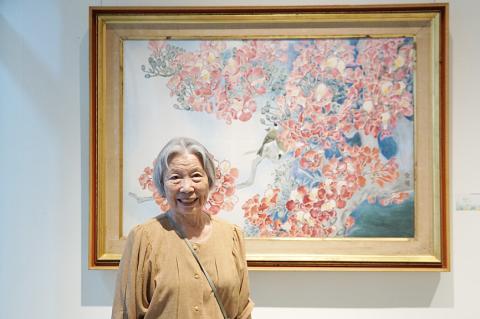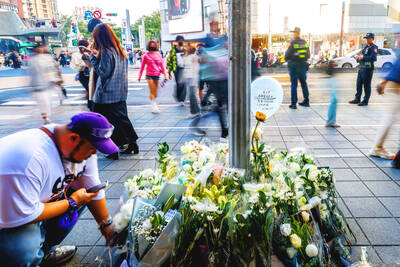Lin Hsing-hua (林星華) is one of the nation’s new female artists whose expertise is Eastern gouache painting.
A student of artist Lin Chih-chu (林之助) — dubbed the father of Eastern gouache painting in Taiwan — Lin Hsing-hua said she swore to him that she would never give up the style after Lin Chih-chu told her that his female students tended to quit.
Born in Taichung in 1932, Lin Hsing-hua did not take art lessons as a child, but learned how to make clothes at Taichung Home Economics and Commercial High School.

Photo: Ho Tsung-han, Taipei Times
She impressed her teachers by being able to draw near-perfect lines freehand, to the point where one teacher asked her to make a suit for a child.
At the National Taichung University of Education, Lin Hsing-hua became Lin Chih-chu’s student.
Lin Hsing-hua said that he first taught her how sketch and paint in watercolors, but noting her special interest in painting, he began tutoring her on the basics of Eastern gouache painting — including how to prepare the paper, sketch and apply color — outside of class.
Eastern gouache painting was introduced to Taiwan during the Japanese colonial period and is often referred to as nihonga, a Japanese painting style, to distinguish it from Western styles.
The paint is made by mixing glue with pigments made of minerals, soil, metals or other materials.
“The beauty of Eastern gouache lies in its color,” Lin Hsing-hua said, adding that it does not fade.
“Once it is painted, it is preserved forever,” she said.
Her oldest brother would mail her pigments from Tokyo, where he worked, she said, adding that he would spend thousands of New Taiwan dollars on each package.
The post office mistook one such package for drugs and would not let her take it, she said.
It was powdered oyster shells — a relatively inexpensive pigment-making material, she said.
Lin Hsing-hua said that Lin Chih-chu cared greatly about painting real-life objects, teaching her to pay attention to details such as the direction in which a morning glory plant was growing.
An artist must be familiar with the structure and characteristics of the subject they are painting, be it a flower or a bird, otherwise, an expert could easily spot mistakes, she said.
To paint birds properly, Lin Hsing-hua said she kept pet birds — including a pheasant — to observe their wings and feet.
The Lin Chih-chu Memorial museum near the Willow River (柳川) in Taichung is where she learned to paint.
While a junior at the university, her Red Multiflora Rose was selected to be displayed in the now-defunct Taiwan Provincial Fine Arts Exhibition.
She received awards at that exhibition, the Taiwan Provincial Employees’ and Teachers’ Art Exhibition and the Taiyang Art Exhibition.
Unfortunately, her winning works stayed with the organizers, she said, adding that their whereabouts are unknown.
Lin Chih-chu trusted her, she said, adding that while he asked to see the drafts of other students’ work multiple times throughout the creative process, she only showed him her works after they had been exhibited, as she was afraid that her work would become too similar to his.
Lin Chih-chu’s wife took great care of her, often asking her to stay for dinner after class, she said.
When Lin Chih-chu founded the Taiwan Gluepainting Association in 1983, she served as a member of the supervisory committee.
During the Martial Law era, accomplished students were required to join the Chinese Nationalist Party (KMT), she said.
Her younger brother Lin Hsin-chih (林心智) pursued a doctoral degree in child psychology at the University of Georgia in the US, but after he completed his studies, the KMT would not allow him to return to Taiwan because he was not a member of the party, she said, adding that he was not allowed to return even when their mother passed away.
Lin Hung-hsuan (林弘宣), her other younger brother, who was the executive secretary of Formosa Magazine’s (美麗島雜誌) service center, was jailed on Green Island (綠島) for many years following the Kaohsiung Incident, she said, adding that he was not released until he was diagnosed with lymphoma.
The Kaohsiung Incident, also known as the Formosa Incident, took place on Dec. 10, 1979, when the then-KMT government cracked down and imprisoned participants in an anti-government parade organized by the magazine.
For herself, she said most of her abstract paintings were created during the Martial Law era, but added that as the paintings could be interpreted according to each person’s taste, she avoided trouble.
For example, a painting titled Work Hard (打拚) on the surface represented the labor of the people, when in fact it had a hidden message that people were trapped, she said.

SHIPS, TRAINS AND AUTOMOBILES: The ministry has announced changes to varied transportation industries taking effect soon, with a number of effects for passengers Beginning next month, the post office is canceling signature upon delivery and written inquiry services for international registered small packets in accordance with the new policy of the Universal Postal Union, the Ministry of Transportation and Communications said yesterday. The new policy does not apply to packets that are to be delivered to China, the ministry said. Senders of international registered small packets would receive a NT$10 rebate on postage if the packets are sent from Jan. 1 to March 31, it added. The ministry said that three other policies are also scheduled to take effect next month. International cruise ship operators

HORROR STORIES: One victim recounted not realizing they had been stabbed and seeing people bleeding, while another recalled breaking down in tears after fleeing A man on Friday died after he tried to fight the knife-wielding suspect who went on a stabbing spree near two of Taipei’s busiest metro stations, Taipei Mayor Chiang Wan-an (蔣萬安) said. The 57-year-old man, identified by his family name, Yu (余), encountered the suspect at Exit M7 of Taipei Main Station and immediately tried to stop him, but was fatally wounded and later died, Chiang said, calling the incident “heartbreaking.” Yu’s family would receive at least NT$5 million (US$158,584) in compensation through the Taipei Rapid Transit Corp’s (TRTC) insurance coverage, he said after convening an emergency security response meeting yesterday morning. National

PLANNED: The suspect visited the crime scene before the killings, seeking information on how to access the roof, and had extensively researched a 2014 stabbing incident The suspect in a stabbing attack that killed three people and injured 11 in Taipei on Friday had planned the assault and set fires at other locations earlier in the day, law enforcement officials said yesterday. National Police Agency (NPA) Director-General Chang Jung-hsin (張榮興) said the suspect, a 27-year-old man named Chang Wen (張文), began the attacks at 3:40pm, first setting off smoke bombs on a road, damaging cars and motorbikes. Earlier, Chang Wen set fire to a rental room where he was staying on Gongyuan Road in Zhongzheng District (中正), Chang Jung-hsin said. The suspect later threw smoke grenades near two exits

The Forestry and Nature Conservation Agency yesterday launched a gift box to market honey “certified by a Formosan black bear” in appreciation of a beekeeper’s amicable interaction with a honey-thieving bear. Beekeeper Chih Ming-chen (池明鎮) in January inspected his bee farm in Hualien County’s Jhuosi Township (卓溪) and found that more than 20 beehives had been destroyed and many hives were eaten, with bear droppings and paw prints near the destroyed hives, the agency said. Chih returned to the farm to move the remaining beehives away that evening when he encountered a Formosan black bear only 20m away, the agency said. The bear